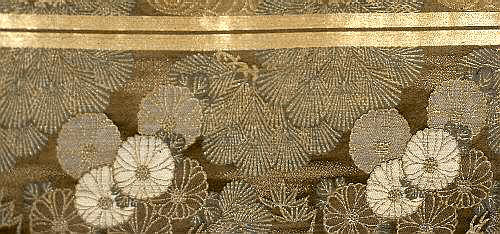Description
Extraordinary coloring, from all natural dyes, with a most unusual motif add to the superiority and exclusivity of this late 1700s, early 1800s Maru Obi.
This is an extraordinarily old, rare, hand woven Silk “Maru Obi,” in exquisite condition. A Maru Obi is the most formal and most expensive of the Japanese Obi. A Maru Obi has but one seam, and has been woven in a continuous repeat pattern and folded over to create 2 visions of the same dramatic scene. A unique feature of the Maru Obi (found only in some antique examples) is a dyeing and weaving process that, when viewed from different angles, appears to make the colors change. The colors are from natural dyes and are the more traditional colors of ancient Japan.
Considering that this Obi dates from the late 1700s to early 1800s, it is in absolutely phenomenal condition. It has a dark brown background with an all over repeat pattern of gold and green Chrysanthemum (“Kiku”), Pine (“Matsu”), Bamboo (“Take”), stylized Waves (“Nami”) and a striking and unusual long tailed Bird. Each of the elements of the design are outlined in pure Gold threads, strengthening the design itself and adding to the overall sheen of the Obi. Each individual shape carries symbolic significance within the Japanese culture. The Chrysanthemum are the flower of the Imperial Family, while the Pine represents longevity; the Bamboo stands for strength and flexibility; and the Wave pattern expresses dynamic motion. The darker colors indicate that a married woman wore this stunning Obi. The intricacy of the design and the unusual and striking colors attest to the artistry of the weaver, while the pure Gold in the pattern and in the bold stripes at the bottom of the Obi denote that a woman of high rank and wealth in Japanese society wore this dramatic garment.
A Certificate of Authenticity is included.
TTAC will personally pack and ship via UPS at company expense within the continental U.S.








